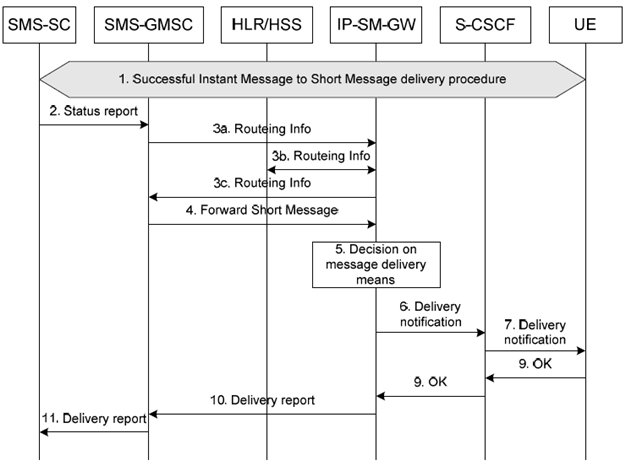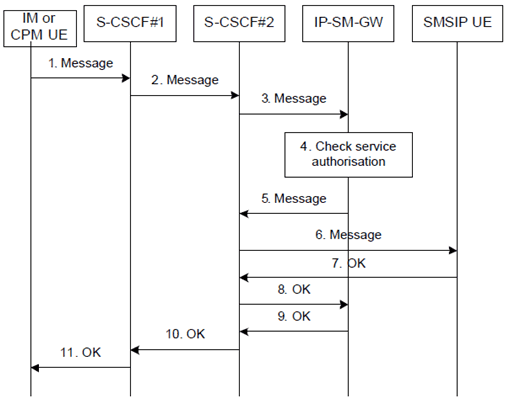Content for TS 23.204 Word version: 17.0.0
6.10 Service-level interworking: Status Report procedure for Instant Message to Short Message interworking
6.11 IM or CPM user sends an Instant Message to an SMSIP UE
...
...
6.10 Service-level interworking: Status Report procedure for Instant Message to Short Message interworking |R8| p. 35

Figure 6.10: Status report procedure for Instant Message to Short Message interworking
(⇒ copy of original 3GPP image)
(⇒ copy of original 3GPP image)
Step 1.
An Instant Message from the UE is successfully delivered to the SMS user after service-level interworking. The original Instant Message requested a Disposition Notification.
Step 2.
The SMS-SC sends a Status report to the SMS-GMSC.
Step 3a.
The SMS GMSC interrogates the HLR/HSS to retrieve routeing information. Based on the pre-configured IP-SM-GW address for the user, the HLR/HSS forwards the request to the corresponding IP-SM-GW.
Step 3b.
The HLR/HSS returns the IMSI and the address(es) of the current MSC, SGSN, MME and/or SMSF to the IP-SM-GW for delivery of the Short Message in CS/PS domain.
Step 3c.
The IP-SM-GW creates a MT Correlation ID as per TS 23.040, which associates the Routing Info retrieval with the subsequent Forward Short Message messages(s), and stores this along with the IMSI of the receiving subscriber. The IP-SM-GW returns to the SMS-GMSC the address of itself, along with the MT Correlation ID in the IMSI field, as routeing information. Alternatively, the IP-SM-GW may return the address(es) of the current MSC, SGSN, MME and/or SMSF, in which case, the subsequent procedure to forward the message is the same as defined in TS 23.040.
Step 4.
The SMS-GMSC sends the status report in the Forward Short Message to the IP-SM-GW.
Step 5.
The IP-SM-GW translates and maps the Status report in the Forward Short Message into an Instant Message carrying a Delivery Notification as described in the IETF IMDN draft-ietf-simple-imdn [13]. The IP SM GW should keep the message id for a message for which IMDN was requested so it can send the message id to the UE in the IMDN.
Step 6-7.
The IP-SM-GW sends a Delivery Notification within an Instant Message to the S-CSCF, which sends the Instant Message to the UE.
Step 8-9.
The UE acknowledges receipt of the Instant Message containing the Delivery Notification to the S-CSCF. The S CSCF sends the acknowledgment to the IP-SM-GW.
Step 10.
The IP-SM-GW sends a Delivery report (SMS-DELIVER-REPORT) to the SMS-GMSC.
Step 11.
The SMS-GMSC sends an acknowledgement back to the SMS-SC.
6.11 IM or CPM user sends an Instant Message to an SMSIP UE |R8| p. 36
An IMS registered user with SIMPLE IM service or CPM service sends an Instant Message via service-level interworking as an encapsulated Short Message to an SMSIP UE, which did not indicate support for SIMPLE IM or CPM when registering to IMS.

Figure 6.11: Successful UE termination Instant Message to encapsulated Short Message procedure
(⇒ copy of original 3GPP image)
(⇒ copy of original 3GPP image)
Step 1.
IM or CPM UE sends an Instant Message to the S-CSCF#1. The UE may request to hide its Public User Identity from the recipient within the Instant Message, as described in OMA TS SIMPLE_IM V1_0 [12] and in OMA-TS-CPM_Conv_Fnct-V1_0 [17].
Step 2.
The S-CSCF#1 forwards the Instant Message to the S-CSCF#2.
Step 3.
The S-CSCF#2 forwards the Instant Message to the IP-SM-GW based on iFC.
Step 4.
Based on user subscription and authorisation for service-level interworking, on operator policy and user preferences, and on UE capability indicated during IMS registration, the IP-SM-GW shall decide whether to perform service-level interworking. If the user is subscribed and authorised for transport-level interworking, and based on UE capability indicated during IMS registration, and on operator policy and user preferences, the message may be delivered as an encapsulated Short Message to the UE over IMS. Otherwise, the Short Message is delivered over CS/PS, as described in clause 6.13. If the sender of the Instant Message requests to hide its Public User Identity from the recipient and operator policy allows for this, the IP SM GW shall anonymise the identity of the user to the recipient. Otherwise, if operator policy prohibits this, the IP SM GW shall return an appropriate error to the user.
Step 5.
The IP-SM-GW forwards the encapsulated Short Message to the S-CSCF#2.
Step 6.
The S-CSCF#2 forwards the encapsulated Short Message to the SMSIP UE.
Step 7.
The SMSIP UE acknowledges the translated encapsulated Short Message.
Step 8.
The S-CSCF forwards the acknowledgement of the translated encapsulated Short Message to the IP-SM-GW.
Step 9-11.
The IP-SM-GW forwards the acknowledgement of the translated encapsulated Short Message to the originating IM UE or CPM UE.